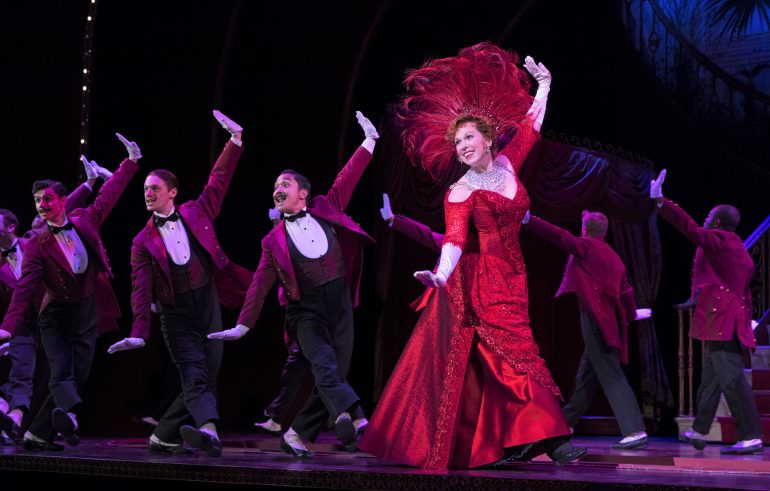
Hello, Dolly! Music & lyrics by Jerry Herman. Directed by Jerry Zaks. National tour at the Academt of Music, Philadelphia through March 1, 2020.
She’s back where she belongs — to paraphrase the famous lyric. Jerry Herman’s Dolly is once again “arranging things” as Hello, Dolly! plays Philadelphia on its national tour.
With 33 performers and 18 musicians in the orchestra (almost as many as on Broadway), this is a glorious revival. The singers dance, and the dancers move with precision and elan, every gesture and every skirt twirl executed perfectly. And it’s great to hear a real live brass section in the pit.
Warren Carlyle’s choreography adds an interesting touch with moments of freeze-frame, which give extra impact to the movements when they resume. Even the 14th Street Parade has an interlude of stop-motion. The title song pays tribute to Gower Champion’s 1964 original creation, while the waiters’ gallop (just before Dolly’s arrival at the Harmonia Gardens) introduces leaps and entrechats that are more balletic than ever before.
Director Jerry Zaks has embraced the show’s old-fashioned qualities, and uses quaint drop-curtains with views of nineteenth-century Manhattan. A steam locomotive and a trolley drawn by a horse with prancing human legs add excitement. It’s all of a piece; the presentation matches the show’s subject.
Hello, Dolly! is not only nostalgia about the nineteenth century, it is also a reminder of Broadway’s golden age when the cast album was a best-seller while the show’s title song was number one on the pop charts.
Everyone wants to know, of course, how the tour’s star, Carolee Carmello, compares to Bette Midler who headlined the revival in New York. I saw the Broadway production with Midler and, later, with Bernadette Peters, and here’s the bottom line: Midler was the funniest, Peters the most tender, and Carmello has the most substantial voice. She belts the songs authoritatively, with humor and warmth, and moves more fluidly than Midler.
As for the competing Horace Vandergelders, David Hyde Pierce was clueless, Victor Garber was very human, and the tour’s John Bolton plays him as a buffoon. This is harmful to the plot development, robbing the show’s romantic denouement (“Wonderful woman!”) of believability.
The young clerks in Vandergelder’s hay and feed store, Daniel Beeman and Sean Burns, are charming and do much more dancing than in earlier productions. Analisa Leaming acts appealingly and has a lovely voice as Irene, the owner of the hat store. Chelsea Cree Groen is comically energetic as Minnie.
Santo Loquasto’s costumes are dazzling, with bustled skirts, elaborate hats and parasols, top hats and tailcoats.
I’ll close with an historically informative memory from a conversation I had with Jerry Herman about the songs he wrote for this show:
“I never liked Dolly’s opening song, ‘When a man with a timid tongue / Meets a girl with a diffident air.’ That’s not Dolly Levi from the Lower East Side. That’s me relying on my revue-material style that I was comfortable with. When they made the movie version, I had a chance to finally get it right and I replaced it with ‘I have always been a woman who arranges things / For the pleasure and the profit it derives…Just leave everything to me.’”